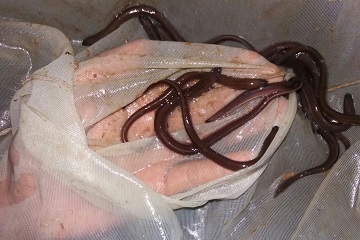IPB Experts Evaluated the Production Performance of Eels on Difference Salinity Media

Asia is the home of aquaculture, a practice which dates back to thousands of years. In the course of its development, the nature of aquaculture has become more intricate, intertwining with other food production sectors under the influence of political, social, economic, technological and cultural factors. With advancement of technology, the involvement of more aquatic species and farming practices has become possible, and more choices can be offered to the consumers. Population growth, economic growth and the development of disposable income and higher purchasing power, and social factors such as traditional fish consumption patterns, will shape future demand for fish and fishery products. Eels, Anguilla spp. despite their snakelike appearance, are true fish, possessing gills and very small scales. They are bottom dwelling, nocturnal in habit, and feed on invertebrates and small finfish. Delicatessen specialties made from hot smoked eel meat such as canned jellied eel are in great demand. It is one of the highest economical aquaculture commodities with high demand in international area, the price is around Rp 180 thousand – Rp 225 thousand per kilogram. However, a high mortality rate is still a common problem encountered in the cultivation process, due to the inability of eels to adapt to the cultivation environment.
Freshwater eel (Anguilla spp.) is a catadromus fish that migrates from freshwater into seawater for spawning and return to freshwater during larvae stage to grow. The life cycle of the freshwater eel includes five stages: the leptocephalus, glass eel, elver, yellow eel and silver eel stages. Larvae, leptocephali, drift and are transported along ocean currents at the continental shelf. These leptocephali leave oceanic currents after metamorphosing into glass eels and then typically migrate upstream as elvers four to eight months after hatching to grow in fresh water habitats during the yellow stage (immature stage). After undergoing upstream migration, elvers become yellow eels and live in fresh water habitats such as rivers and lakes. Then, during the silver eel stage (early maturing stage), their gonads begin to mature and they begin their downstream migration into the ocean and back out to the spawning area where they spawn and die. Eel fish are also carnivorous fish that have slow growth.
In addition, salinity is one of the more important environmental factors that will determine potential range of swamp eels. Salinity range in eels maintenance media at the stage of nursery are very important, because it will affect its feed consumption, growth rate, and survival. This is due to the work of osmotic fish relating to energy use. Fish cells require a balanced condition between the outer ions and the ions in the body of the fish.
Therefore, the team of researchers of the Department of Aquaculture, of the Faculty of Fisheries and Marine Sciences of Bogor Agricultural University (FPIK IPB) consisting of Tatag Budiardi, Oman Agus Sudrajat and Yani Hadiroseyani implemented the research program to evaluate the life cycle of the Anguilla spp. The aim of this study was to evaluate the effect of salinity differences on the eel production performance. This research tries to keep the eel fish on the medium of salinity (having salt content) with some treatments.
The experimental revealed that the best media salinity for both phases of fish is 0 g.L-1 (without salinity) based on absolute biomass growth rate (LPMB) and survival rate (DKH). Overall, fingerling of eels is able to adapt to a range of media salinity. (Wied)


